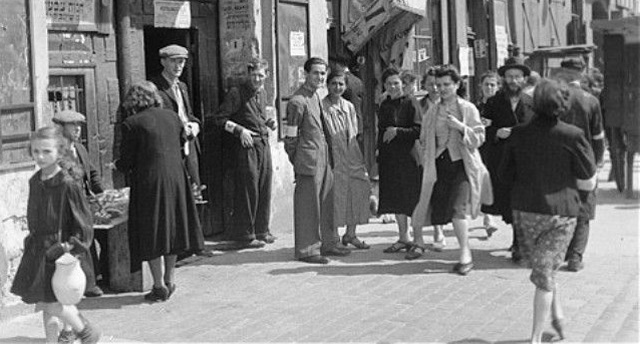Program to commemorate Warsaw ghetto uprising
Anniversary to be marked with a program of Yiddish songs and diary texts

Jews on the street in the Warsaw ghetto.
To mark the anniversary of the Warsaw ghetto uprising, literary scholar Susanne Klingenstein MA ‘83, pianist Eugenia Gerstein and mezzo-soprano Sophie Michaux are presenting a program of Yiddish songs and diary texts at Brandeis and two other Greater Boston venues.
At Brandeis, Klingenstein will be joined as narrator by Professor Kathy Lawrence, PhD. Mezzo-soprano Michaux and pianist Gerstein will be joined by Cantor Elias Rosemberg and the Temple Emanuel Choir of Newton, conducted by Gerstein and accompanied by Jeremiah Klarman of Berklee College of Music. The event will be held from 4:30 to 6 p.m. in Rapaporte Treasure Hall in the Goldfarb Library.
The following narrative of the uprising was written by Klingenstein.
----
On September 29, 1939, the Germans arrived in Warsaw.
Harassment and brutalization of Jews in the streets and in their homes began right away. On October, 12, 1940, the eve of Yom Kippur, the Germans announced the establishment of a ghetto in the old Jewish section in the north of Warsaw. Within a year it was filled to capacity: in March 1941, some 450,000 Jews were living in just 14,000 residential buildings, seven or eight people to a room.
On July 22, 1942, the day of Tisha b’Av, the deportations began. Within 45 days, 253,000 Jews had been killed or deported to Treblinka. On September, 12, 1942, the Germans mysteriously stopped their Aktion (initiative).
Stunned and incapable of feeling anything, the 73,000 remaining Jews came out of their hiding places Slowly their souls filled with rage. Two resistance groups reorganized themselves, tried to buy weapons from the Polish underground and got ready to fight.
On January 18, 1943, the Germans returned. They were in for a surprise: They were shot at by the Jews, suffered casualties and did not manage to fill their quota of 8,000 Jews. This had never happened before.
The Germans withdrew and did not return until April 19. The Jews were ready for them. Some 750 poorly armed Jews attacked the 2,000 well-nourished Germans who moved into the ghetto with tanks, cannons and flame-throwers.
In the afternoon of the first day of fighting, two boys climbed onto a roof and unfurled two flags -- a red and white one for Poland and a blue and white one for the Jews, raising the fighting spirit of the Jews. It took the Germans three weeks to defeat the Jews.
On May 16, it was all over. At 8:15 that evening, the Germans blew up the grand synagogue on Tlomackie Street, a symbolic gesture that signified the end of the Jews of Warsaw. The commander of the Aktion reported to his superior in Cracow: “The former Jewish quarter of Warsaw no longer exists.”
Of the remaining Jews, 17,000 had been killed on the spot; 7,000 were sent to Treblinka, and 42,000 were sent to Majdanek, near Lublin.
The news that Jews had taken up arms against the Germans was of enormous moral and psychological importance to the Jews living under Nazi rule and left a legacy of courage that reverberates to this day.
---
Hundreds of diaries, thousands of poems, songs and stories were written during the destruction of European Jewry (1938-1945) and during the first years of commemoration. A new book, "Holocaust Literature: A History and Guide," has recently been published by Brandeis University Press and is an indispensable guide.
This study guide asks: What is Holocaust literature? When does it begin and how is it changing? Is there an essential core of diaries, eyewitness accounts of the concentration camps, tales of individual survival in hiding? What works of Holocaust literature will be read a hundred years from now—and why?
---
Other presentations of the program will be:
- on April 17, from 6 to 7:30 p.m. at Congregation Mishkan Tefila, 700 Hammond Pond Parkway in Chestnut Hill. That will be followed by a symposium titled “Armed and Moral Resistance,” chaired by Professor John Michalczyk, and moderated by Professor Lorenz Reibling, both of Boston College, and featuring excepts from Roman Polanski’s 2001 film “The Pianist,” about a Jewish musician who was saved by a German Wehrmacht officer. Documentary filmmaker Marian Marzynski, who escaped from the Warsaw ghetto as a child will participate in the panel discussion, following the movie. [More information]
- on April 19 from 6 to 7:30 p.m., at the Goethe Institut, 170 Beacon St., Boston. Klingenstein, Gerstein and Michaux will present their narrative and musical program. Noted cellist Ronald Crutcher, the President of Wheaton College, and Eugenia Gerstein will play a section from “Jewish Life” by Ernest Bloch. For more information see the Goethe Institut website.
Categories: Humanities and Social Sciences, International Affairs





